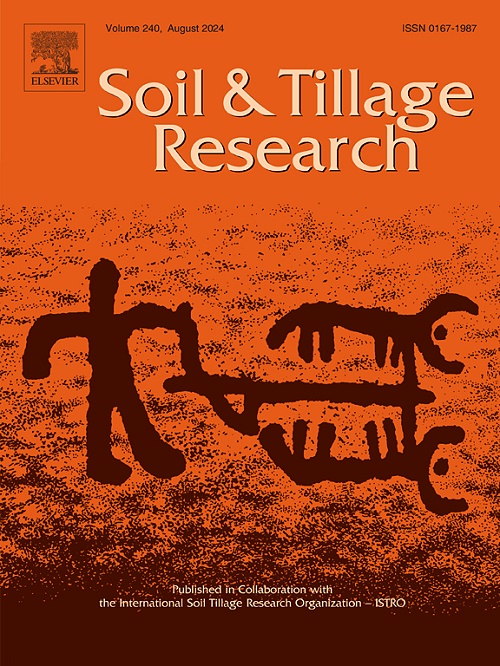Nano silicon causes a shift in rhizospheric soil microbial community structure and improves nutrient uptake and assimilation in tomato plants under low temperature
IF 6.1
1区 农林科学
Q1 SOIL SCIENCE
引用次数: 0
Abstract
Low temperatures pose a significant threat to agricultural production, particularly during early spring, late autumn, and winter in northern China, adversely affecting the yield and quality of cold-sensitive crops, such as tomato (Solanum lycopersicum L.). Nano-silicon (SiNPs) represent a prominent application of nanotechnology in agriculture, owing to their unique structure and physicochemical properties, which have demonstrated remarkable efficacy in enhancing plant stress resistance. In this study, we utilized 'Zhongza 9′ tomato cultivar as the test material to investigate the effects of SiNPs, applied through foliar spraying at a concentration of 100 mg·L−1, on nutrient uptake and the microbiome of tomato roots under low-temperature stress. The experiments were conducted using substrate culture at room temperature (25/16℃) and low temperature (15/6℃). The results indicated that the application of SiNPs could enhance the cold tolerance of tomato plants by improving root configuration, photosynthetic capacity, antioxidant capacity, carbon and nitrogen metabolism, as well as nutrient absorption and utilization. Furthermore, SiNPs were found to influence the structure of the rhizosphere microbial community, thereby promoting soil nutrient release. This study elucidates the intricate dynamics between roots, soil, and microbes in mitigating low-temperature stress in plants. Moreover, it provides a crucial theoretical framework for advancing the utilization of SiNPs in agricultural contexts, offering valuable insights for enhancing agricultural productivity in challenging environmental conditions.
低温条件下,纳米硅能改变番茄根际土壤微生物群落结构,促进番茄植株对养分的吸收和同化
低温对农业生产构成重大威胁,特别是在中国北方的早春、深秋和冬季,对番茄等冷敏感作物的产量和品质产生不利影响。纳米硅(SiNPs)以其独特的结构和理化性质,在提高植物抗逆性方面表现出显著的效果,是纳米技术在农业领域的重要应用。以“中扎9号”番茄为试验材料,研究了低温胁迫下叶面喷施浓度为100 mg·L−1的SiNPs对番茄根系养分吸收和微生物组的影响。实验采用底物培养,室温(25/16℃)和低温(15/6℃)。结果表明,施用SiNPs可以通过改善番茄根系形态、光合能力、抗氧化能力、碳氮代谢和养分吸收利用等提高番茄植株的耐寒性。此外,还发现SiNPs影响根际微生物群落结构,从而促进土壤养分释放。本研究阐明了植物根系、土壤和微生物在缓解低温胁迫中的复杂动态关系。此外,该研究还为推进sinp在农业环境中的利用提供了重要的理论框架,为在具有挑战性的环境条件下提高农业生产力提供了有价值的见解。
本文章由计算机程序翻译,如有差异,请以英文原文为准。
求助全文
约1分钟内获得全文
求助全文
来源期刊

Soil & Tillage Research
农林科学-土壤科学
CiteScore
13.00
自引率
6.20%
发文量
266
审稿时长
5 months
期刊介绍:
Soil & Tillage Research examines the physical, chemical and biological changes in the soil caused by tillage and field traffic. Manuscripts will be considered on aspects of soil science, physics, technology, mechanization and applied engineering for a sustainable balance among productivity, environmental quality and profitability. The following are examples of suitable topics within the scope of the journal of Soil and Tillage Research:
The agricultural and biosystems engineering associated with tillage (including no-tillage, reduced-tillage and direct drilling), irrigation and drainage, crops and crop rotations, fertilization, rehabilitation of mine spoils and processes used to modify soils. Soil change effects on establishment and yield of crops, growth of plants and roots, structure and erosion of soil, cycling of carbon and nutrients, greenhouse gas emissions, leaching, runoff and other processes that affect environmental quality. Characterization or modeling of tillage and field traffic responses, soil, climate, or topographic effects, soil deformation processes, tillage tools, traction devices, energy requirements, economics, surface and subsurface water quality effects, tillage effects on weed, pest and disease control, and their interactions.
文献相关原料
公司名称
产品信息
索莱宝
glutamine synthetase
索莱宝
Nitrate reductase
 求助内容:
求助内容: 应助结果提醒方式:
应助结果提醒方式:


